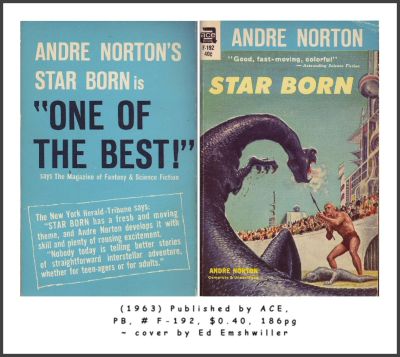Return to Astra
Star Born (Pax, volume 2)

30 Jan, 2015
0 comments
1957’s Star Born returns to the universe of 1954’s The Stars Are Ours! It is not a long book, but Norton manages to get more value out of her limited page count than later authors could do with much longer narratives.
Two centuries have passed, during which time the descendents of the Scientists who discovered Astra have settled into comfortable (if technologically backward) lives next to their merman allies. The one sour note in their bucolic existence is the merman suspicion that the Others, the hubristic aliens who once ruled Astra, still survive in a stronghold over the sea.
Although the humans of Astra have no way to know this, two centuries have brought great changes back on Earth. Pax has been overthrown, replaced by the Federation of Free Men. Taking up the torch of *S*C*I*E*N*C*E* that the people of Astra had to leave behind, the Federation has launched starship after starship into the interstellar deeps, none of which have ever returned. (A detail of some concern to those unfortunate enough to serve on such ships, as we learn later.)
Lucky ship #10 manages to survive its trip across the cold deeps. It even manages to arrive at a sun-like star with at least one Earth-like planet. In fact, the ship has recapitulated the trip the Scientists took in The Stars Are Ours!, with only one trifling difference: where the Scientists managed to land in a region dominated by the kindly mermen, the Federation ship sets down near the Others.
The Others convince the Terrans to assist them in their grand plan to recover valuable relics of their high civilization, relics to be found in a city now deep within their barbarian enemy’s territory. Aside from the fact the Others are pretty clearly scenery-chewing villains, the Terrans have no reason to doubt the Others’ version of the facts. They set out with their new pals towards the forbidden city, not too far from where the Scientists settled two centuries ago.
The story plays out from two vantage points: Delgard Nordis and his merman friend Sssuri provide the Astran point of view while Raf Kurbi provides the Terran point of view. The events the two men see overlap at several points, although of course Delgard and Raf have very different perspectives. What is clear is that for the merman and their human allies to survive, the Others must fail in their quest for lost technology. Armed with the remnants of their once-great culture, with the might of naïve Earth on their side, the Others will be able to wipe out the pesky mermen once and for all. The human settlers will presumably be bycatch.
As you might guess from the name of the Earth’s new government, the Federation of Free Men, this is another Norton with no female characters of note. It was only later in her career that she started writing novels featuring female protagonists and even matriarchal societies. When she did start writing about women, I am afraid that the reaction from her male readers wasn’t positive. I’d love to be able to say that sort of teeth-gnashing over the specter of diversity died with the 1960s … but I’d be lying. Standard tiger tests [1] indicate a surprising number of men are still pretty hostile to any books openly written by or about women.
I know my comments about the Terrans and the Others may come off as snarky but actually, the reason why the men of Terra willfully ignore the evidence that the Others are pure evil is interesting and not implausible. One of the ways Pax controlled Earth was to encourage racism and other bigotries. By the time of this novel, the very worst sin of which a Terran could be suspected is being a bigot. This puts the Terrans at a huge disadvantage when it comes to accepting their suspicions that the Others are very bad indeed, both individually and as a group.
In light of the great strides the Terrans made since the days of Pax, it’s a shame that some details in this book hint that it takes place in the same universe as Star Guard and Star Ranger. Later Terran explorations will lead to contact with Central, followed by centuries of human service as despised janissaries under alien control. Terrans will be forced to embrace the very sort of violence that they have struggled to put behind them.
Thanks to the length constraints of 1950s genre fiction, Norton doesn’t have all that many pages to tell her story. She does manage to avoid a purely linear plot by dividing the story between Delgard and Raf. It’s increasingly clear that the two story lines have to collide at one point and by giving Delgard and Raf seemingly incompatible goals she ramps up the dramatic tension. It’s not a complicated gambit on Norton’s part, but it is pretty effective.
1: Lock a male reader into a room that contains a copy of Women of Wonder, a room whose door will unlock when he finishes reading the book. There is a hungry Bengal tiger in the room. Most men will prefer to be torn limb from limb rather than read the book! But on the bright side, the tiger will be well fed.
